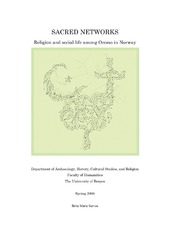Sacred networks Religion and social life among Oromo in Norway
Master thesis
Permanent lenke
https://hdl.handle.net/1956/3029Utgivelsesdato
2008-11-18Metadata
Vis full innførselSammendrag
The main questions in this thesis are: How are religious similarities and differences expressed, and how is diversity tackled, in plural-religious social contexts? These questions and the material call for other questions to be asked, as for example: Why and how do Oromo in Norway socialise within their ethnic group? I suggest some answers based on empirical examples and theoretical reflections, both from previous studies and from my own fieldwork. My aim is to contribute to the study of Oromo, as well as put forward some perspectives on the relation between social life and religion in general.I will in the first part of the thesis examine previous studies. Chapter two briefly presents studies on Oromo history and religions. This will provide background information to the analysis since most Oromo in Norway are first-generation immigrants from Ethiopia. Furthermore, the aim is to discuss some of the shortcomings in previous studies on inter-religious relations among Oromo. Chapter three discusses previous studies on Oromo in diaspora. The intention is to give further background information as well as stress the need for studies on religion and social interaction in the Oromo diaspora.The second part discusses the theories and concepts that are being used in the analysis. Throughout the thesis, I will focus on religion as a social phenomenon. In chapter four, sociological theories such as social networks, cultural capital, and interaction rituals are presented. Chapter five discusses how we could conceptualise deities' in light of previous studies. I attempt to find a way to analyse relations to deities through experimenting with the sociological theories discussed in chapter four. Hence, a central question is: could representations of deities be analysed as part of social networks, religious capital, and interaction rituals? Furthermore, I will present a proposition on how members of plural-religious networks relate to the religious diversity.The final part of the thesis, analyses the material based on qualitative interviews and participating observations among Oromo in Norway. Chapter six will suggest some answers the question: how are relations to deities expressed in social interaction? Through examples from different forms of rituals, I will demonstrate how both religious similarity and diversity are expressed among Oromo in Norway. In addition, this chapter provide some answers to how and why Oromo-Norwegians primarily socialise within their own ethnic group. Chapter seven will examine which strategies the respondents use when dealing with religious diversity, an analysis which is based on the proposition suggested in chapter five.
Utgiver
The University of BergenOpphavsrett
Copyright the author. All rights reservedThe author
